Auditing and Assurance Report: Analysis of Double Ink Printers Limited
VerifiedAdded on 2020/02/18
|13
|2606
|118
Report
AI Summary
This report offers a comprehensive auditing and assurance analysis of Double Ink Printers Limited (DIPL). The analysis begins with an implementation of analytical processes to the financial report, evaluating profitability, liquidity, efficiency, and solvency ratios over three years. It examines the decline in gross profit and return on assets, improvements in liquidity, and the implications of efficiency and solvency ratios. The report then identifies inherent risks stemming from DIPL's business operations, including financial risks related to debt covenants and risks associated with information technology and potential misstatements. Finally, it discusses important risk facets associated with material misstatement in financial reporting, particularly debt covenants and improper segmentation of work, and their impact on audit planning, including the influence of control environment and the need to verify inventory balances and order quantities. The report references several academic sources to support its findings and recommendations.
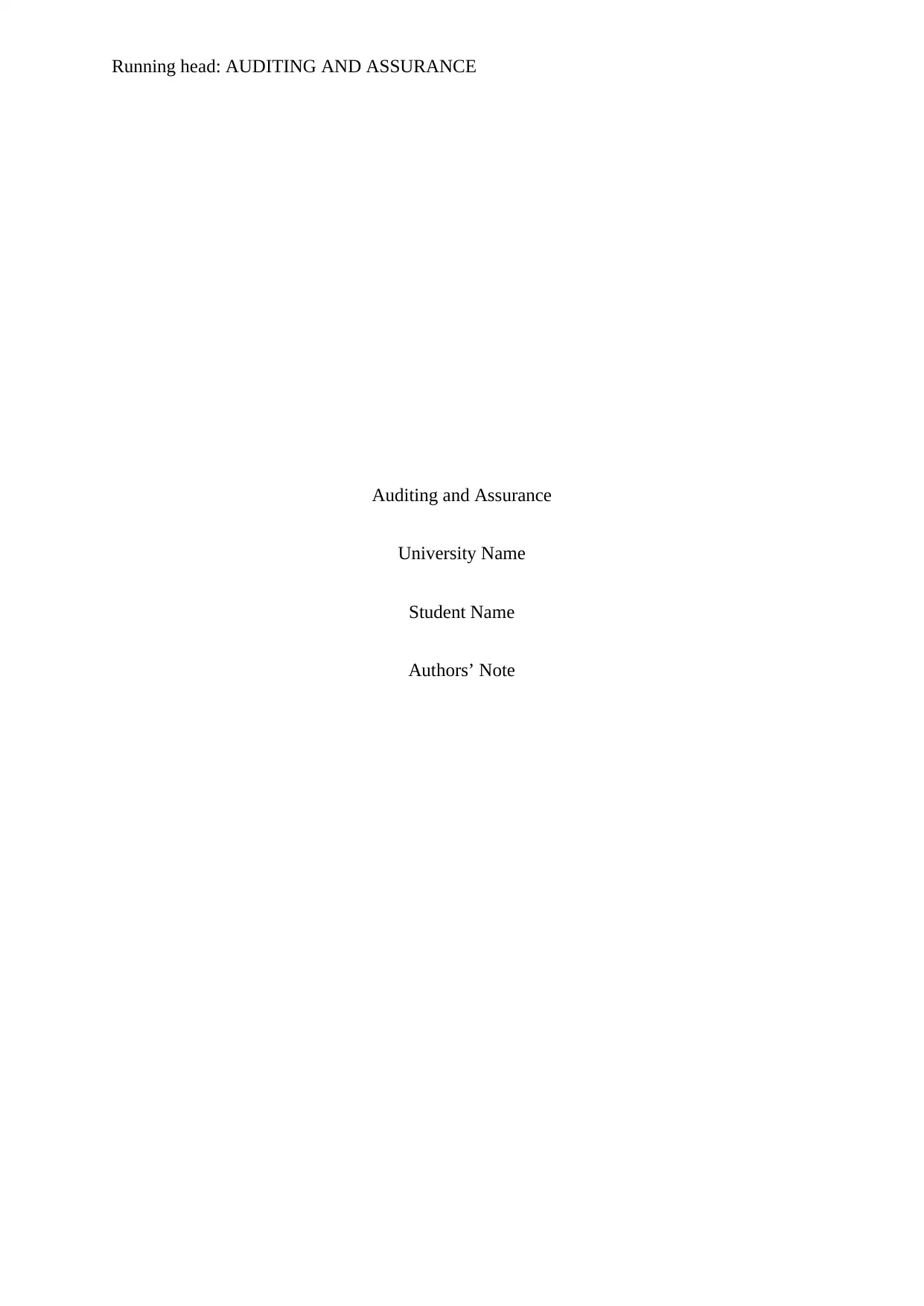
Running head: AUDITING AND ASSURANCE
Auditing and Assurance
University Name
Student Name
Authors’ Note
Auditing and Assurance
University Name
Student Name
Authors’ Note
Paraphrase This Document
Need a fresh take? Get an instant paraphrase of this document with our AI Paraphraser
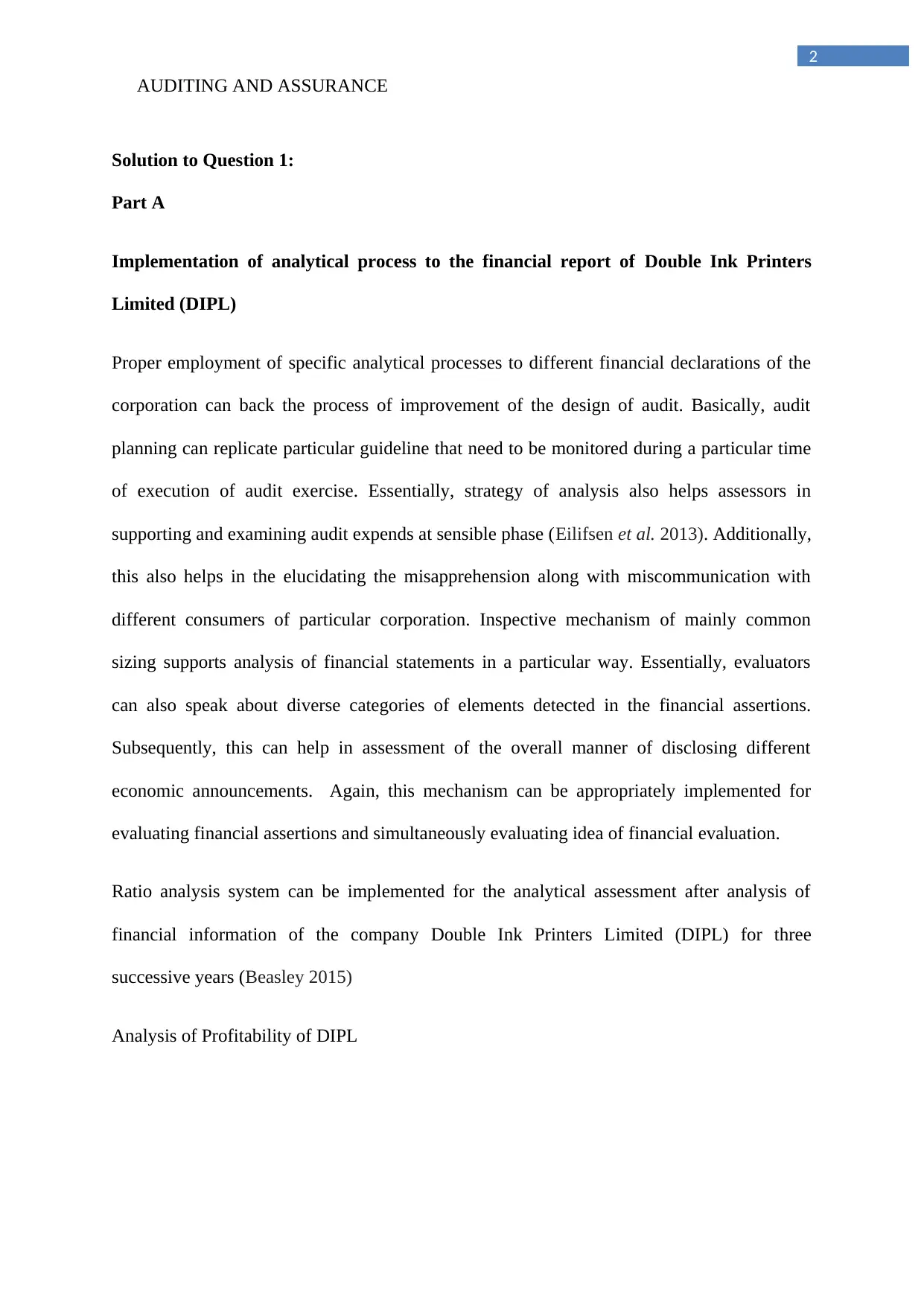
2
AUDITING AND ASSURANCE
Solution to Question 1:
Part A
Implementation of analytical process to the financial report of Double Ink Printers
Limited (DIPL)
Proper employment of specific analytical processes to different financial declarations of the
corporation can back the process of improvement of the design of audit. Basically, audit
planning can replicate particular guideline that need to be monitored during a particular time
of execution of audit exercise. Essentially, strategy of analysis also helps assessors in
supporting and examining audit expends at sensible phase (Eilifsen et al. 2013). Additionally,
this also helps in the elucidating the misapprehension along with miscommunication with
different consumers of particular corporation. Inspective mechanism of mainly common
sizing supports analysis of financial statements in a particular way. Essentially, evaluators
can also speak about diverse categories of elements detected in the financial assertions.
Subsequently, this can help in assessment of the overall manner of disclosing different
economic announcements. Again, this mechanism can be appropriately implemented for
evaluating financial assertions and simultaneously evaluating idea of financial evaluation.
Ratio analysis system can be implemented for the analytical assessment after analysis of
financial information of the company Double Ink Printers Limited (DIPL) for three
successive years (Beasley 2015)
Analysis of Profitability of DIPL
AUDITING AND ASSURANCE
Solution to Question 1:
Part A
Implementation of analytical process to the financial report of Double Ink Printers
Limited (DIPL)
Proper employment of specific analytical processes to different financial declarations of the
corporation can back the process of improvement of the design of audit. Basically, audit
planning can replicate particular guideline that need to be monitored during a particular time
of execution of audit exercise. Essentially, strategy of analysis also helps assessors in
supporting and examining audit expends at sensible phase (Eilifsen et al. 2013). Additionally,
this also helps in the elucidating the misapprehension along with miscommunication with
different consumers of particular corporation. Inspective mechanism of mainly common
sizing supports analysis of financial statements in a particular way. Essentially, evaluators
can also speak about diverse categories of elements detected in the financial assertions.
Subsequently, this can help in assessment of the overall manner of disclosing different
economic announcements. Again, this mechanism can be appropriately implemented for
evaluating financial assertions and simultaneously evaluating idea of financial evaluation.
Ratio analysis system can be implemented for the analytical assessment after analysis of
financial information of the company Double Ink Printers Limited (DIPL) for three
successive years (Beasley 2015)
Analysis of Profitability of DIPL
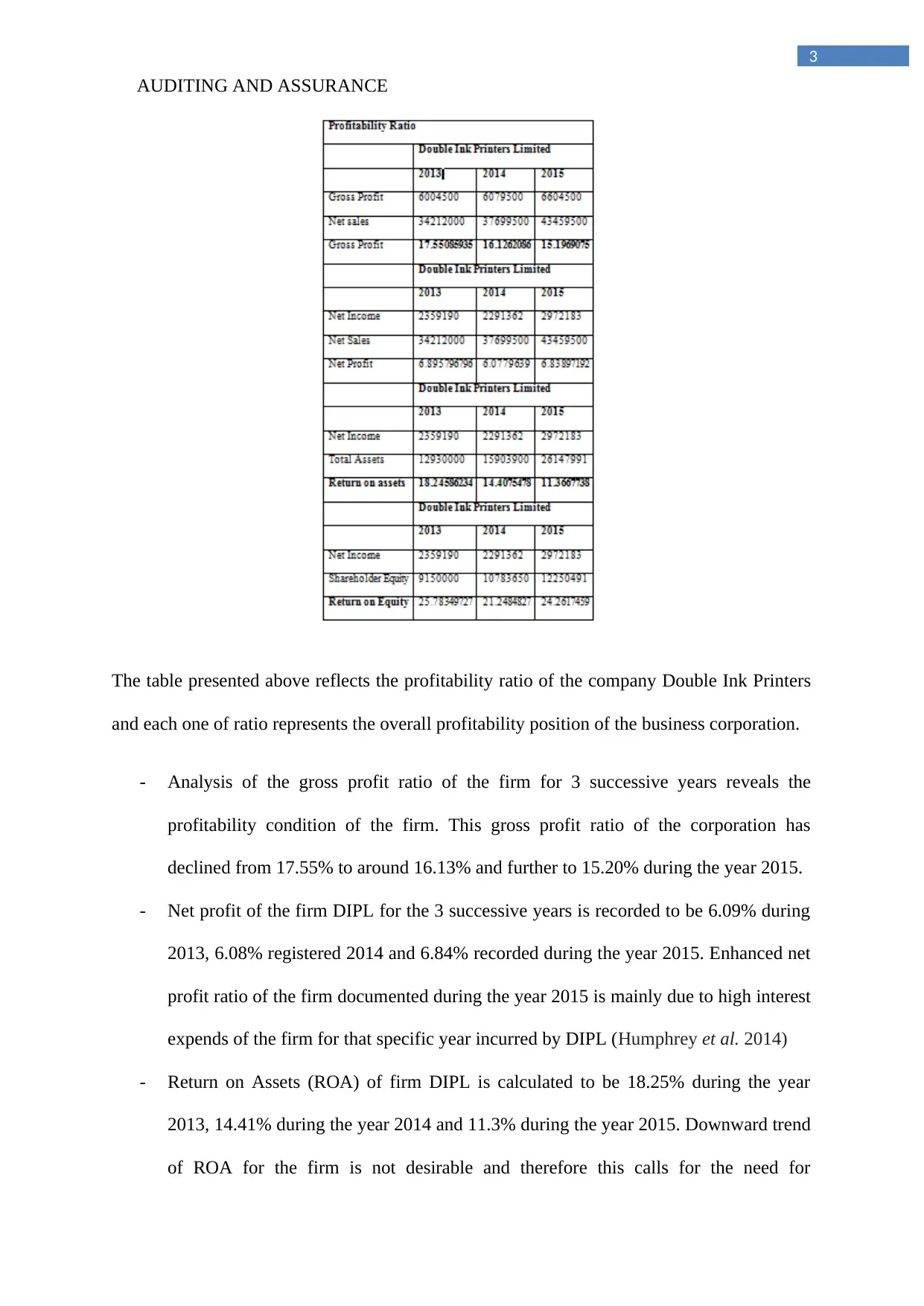
3
AUDITING AND ASSURANCE
The table presented above reflects the profitability ratio of the company Double Ink Printers
and each one of ratio represents the overall profitability position of the business corporation.
- Analysis of the gross profit ratio of the firm for 3 successive years reveals the
profitability condition of the firm. This gross profit ratio of the corporation has
declined from 17.55% to around 16.13% and further to 15.20% during the year 2015.
- Net profit of the firm DIPL for the 3 successive years is recorded to be 6.09% during
2013, 6.08% registered 2014 and 6.84% recorded during the year 2015. Enhanced net
profit ratio of the firm documented during the year 2015 is mainly due to high interest
expends of the firm for that specific year incurred by DIPL (Humphrey et al. 2014)
- Return on Assets (ROA) of firm DIPL is calculated to be 18.25% during the year
2013, 14.41% during the year 2014 and 11.3% during the year 2015. Downward trend
of ROA for the firm is not desirable and therefore this calls for the need for
AUDITING AND ASSURANCE
The table presented above reflects the profitability ratio of the company Double Ink Printers
and each one of ratio represents the overall profitability position of the business corporation.
- Analysis of the gross profit ratio of the firm for 3 successive years reveals the
profitability condition of the firm. This gross profit ratio of the corporation has
declined from 17.55% to around 16.13% and further to 15.20% during the year 2015.
- Net profit of the firm DIPL for the 3 successive years is recorded to be 6.09% during
2013, 6.08% registered 2014 and 6.84% recorded during the year 2015. Enhanced net
profit ratio of the firm documented during the year 2015 is mainly due to high interest
expends of the firm for that specific year incurred by DIPL (Humphrey et al. 2014)
- Return on Assets (ROA) of firm DIPL is calculated to be 18.25% during the year
2013, 14.41% during the year 2014 and 11.3% during the year 2015. Downward trend
of ROA for the firm is not desirable and therefore this calls for the need for
⊘ This is a preview!⊘
Do you want full access?
Subscribe today to unlock all pages.

Trusted by 1+ million students worldwide
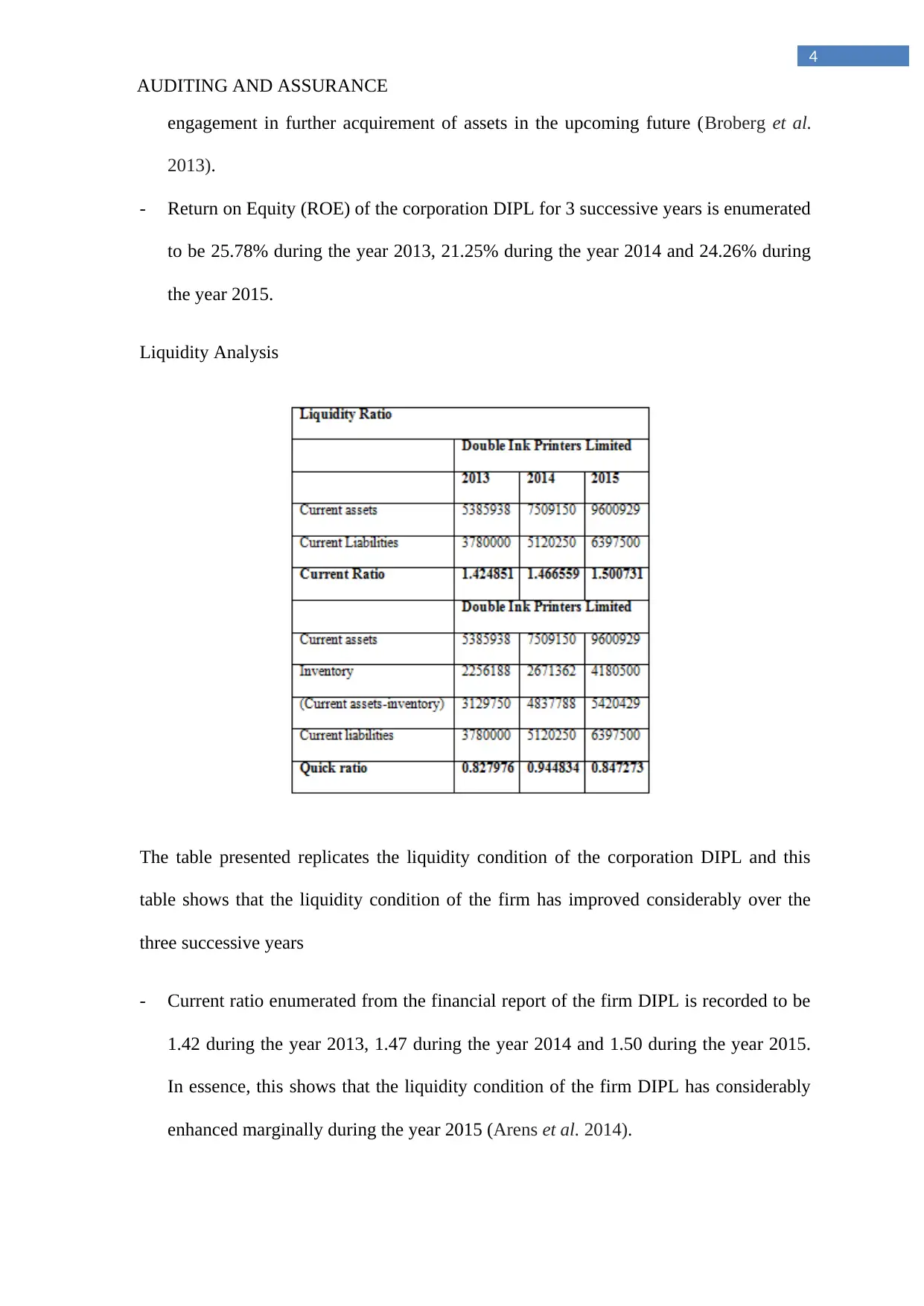
4
AUDITING AND ASSURANCE
engagement in further acquirement of assets in the upcoming future (Broberg et al.
2013).
- Return on Equity (ROE) of the corporation DIPL for 3 successive years is enumerated
to be 25.78% during the year 2013, 21.25% during the year 2014 and 24.26% during
the year 2015.
Liquidity Analysis
The table presented replicates the liquidity condition of the corporation DIPL and this
table shows that the liquidity condition of the firm has improved considerably over the
three successive years
- Current ratio enumerated from the financial report of the firm DIPL is recorded to be
1.42 during the year 2013, 1.47 during the year 2014 and 1.50 during the year 2015.
In essence, this shows that the liquidity condition of the firm DIPL has considerably
enhanced marginally during the year 2015 (Arens et al. 2014).
AUDITING AND ASSURANCE
engagement in further acquirement of assets in the upcoming future (Broberg et al.
2013).
- Return on Equity (ROE) of the corporation DIPL for 3 successive years is enumerated
to be 25.78% during the year 2013, 21.25% during the year 2014 and 24.26% during
the year 2015.
Liquidity Analysis
The table presented replicates the liquidity condition of the corporation DIPL and this
table shows that the liquidity condition of the firm has improved considerably over the
three successive years
- Current ratio enumerated from the financial report of the firm DIPL is recorded to be
1.42 during the year 2013, 1.47 during the year 2014 and 1.50 during the year 2015.
In essence, this shows that the liquidity condition of the firm DIPL has considerably
enhanced marginally during the year 2015 (Arens et al. 2014).
Paraphrase This Document
Need a fresh take? Get an instant paraphrase of this document with our AI Paraphraser
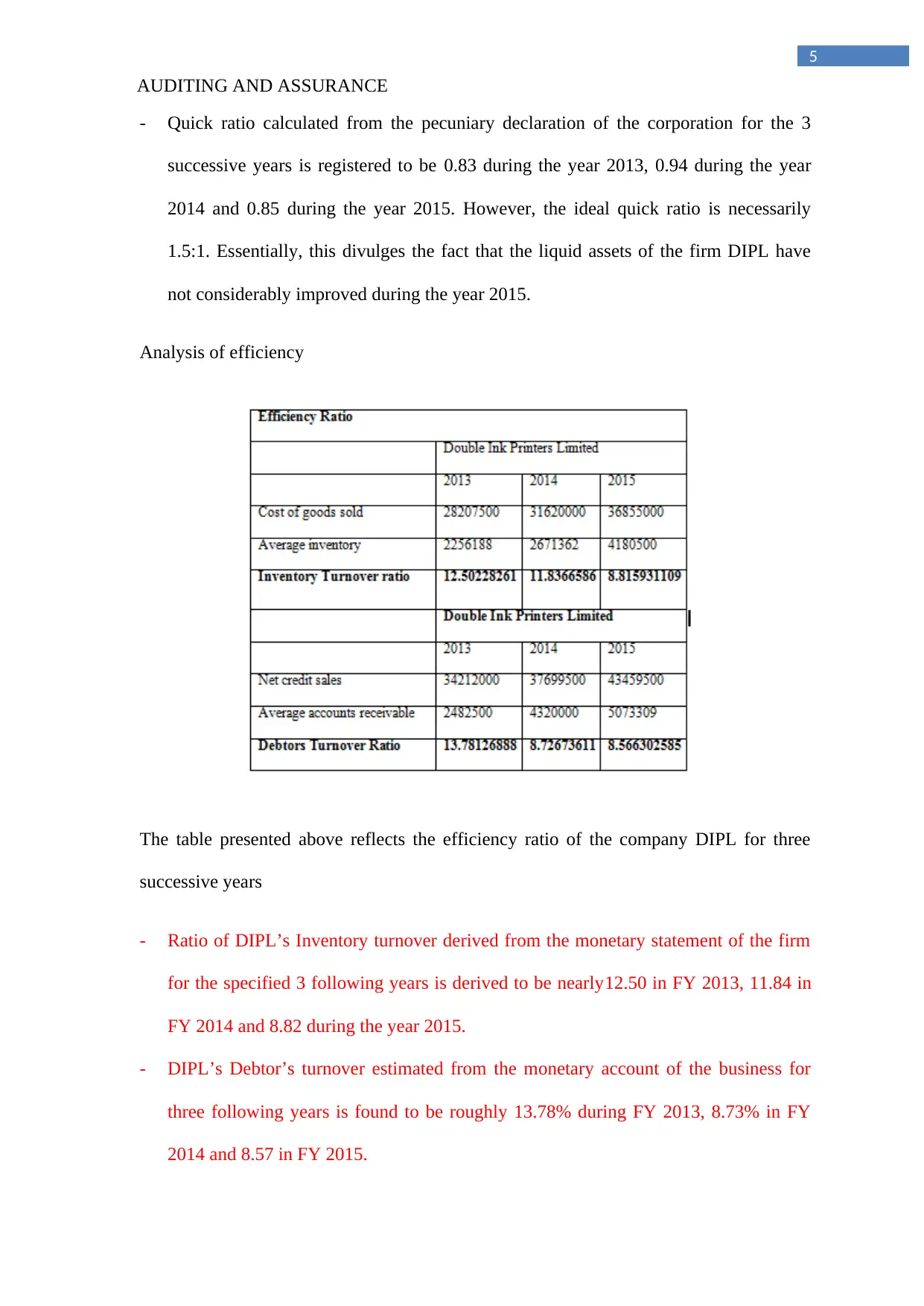
5
AUDITING AND ASSURANCE
- Quick ratio calculated from the pecuniary declaration of the corporation for the 3
successive years is registered to be 0.83 during the year 2013, 0.94 during the year
2014 and 0.85 during the year 2015. However, the ideal quick ratio is necessarily
1.5:1. Essentially, this divulges the fact that the liquid assets of the firm DIPL have
not considerably improved during the year 2015.
Analysis of efficiency
The table presented above reflects the efficiency ratio of the company DIPL for three
successive years
- Ratio of DIPL’s Inventory turnover derived from the monetary statement of the firm
for the specified 3 following years is derived to be nearly12.50 in FY 2013, 11.84 in
FY 2014 and 8.82 during the year 2015.
- DIPL’s Debtor’s turnover estimated from the monetary account of the business for
three following years is found to be roughly 13.78% during FY 2013, 8.73% in FY
2014 and 8.57 in FY 2015.
AUDITING AND ASSURANCE
- Quick ratio calculated from the pecuniary declaration of the corporation for the 3
successive years is registered to be 0.83 during the year 2013, 0.94 during the year
2014 and 0.85 during the year 2015. However, the ideal quick ratio is necessarily
1.5:1. Essentially, this divulges the fact that the liquid assets of the firm DIPL have
not considerably improved during the year 2015.
Analysis of efficiency
The table presented above reflects the efficiency ratio of the company DIPL for three
successive years
- Ratio of DIPL’s Inventory turnover derived from the monetary statement of the firm
for the specified 3 following years is derived to be nearly12.50 in FY 2013, 11.84 in
FY 2014 and 8.82 during the year 2015.
- DIPL’s Debtor’s turnover estimated from the monetary account of the business for
three following years is found to be roughly 13.78% during FY 2013, 8.73% in FY
2014 and 8.57 in FY 2015.
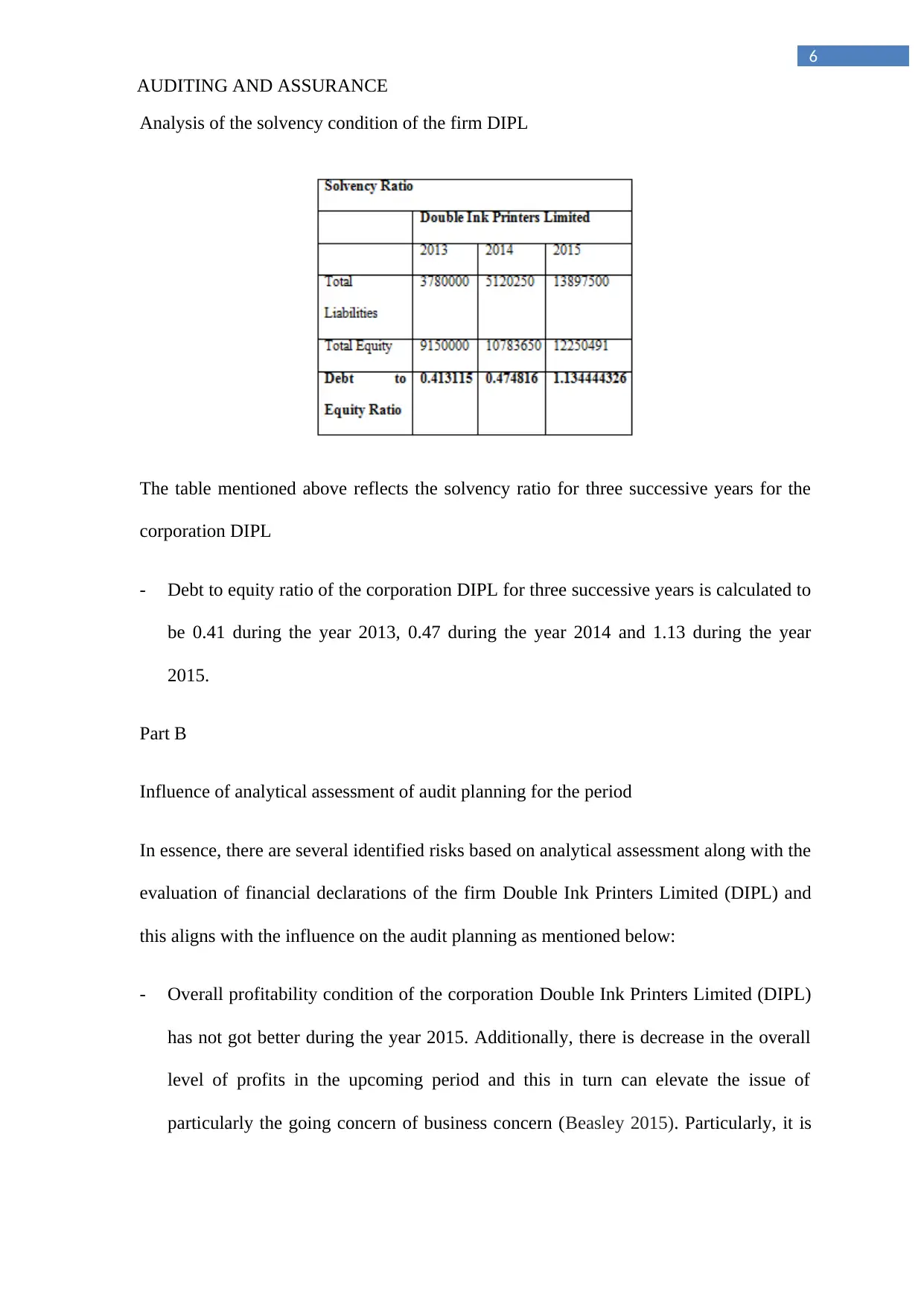
6
AUDITING AND ASSURANCE
Analysis of the solvency condition of the firm DIPL
The table mentioned above reflects the solvency ratio for three successive years for the
corporation DIPL
- Debt to equity ratio of the corporation DIPL for three successive years is calculated to
be 0.41 during the year 2013, 0.47 during the year 2014 and 1.13 during the year
2015.
Part B
Influence of analytical assessment of audit planning for the period
In essence, there are several identified risks based on analytical assessment along with the
evaluation of financial declarations of the firm Double Ink Printers Limited (DIPL) and
this aligns with the influence on the audit planning as mentioned below:
- Overall profitability condition of the corporation Double Ink Printers Limited (DIPL)
has not got better during the year 2015. Additionally, there is decrease in the overall
level of profits in the upcoming period and this in turn can elevate the issue of
particularly the going concern of business concern (Beasley 2015). Particularly, it is
AUDITING AND ASSURANCE
Analysis of the solvency condition of the firm DIPL
The table mentioned above reflects the solvency ratio for three successive years for the
corporation DIPL
- Debt to equity ratio of the corporation DIPL for three successive years is calculated to
be 0.41 during the year 2013, 0.47 during the year 2014 and 1.13 during the year
2015.
Part B
Influence of analytical assessment of audit planning for the period
In essence, there are several identified risks based on analytical assessment along with the
evaluation of financial declarations of the firm Double Ink Printers Limited (DIPL) and
this aligns with the influence on the audit planning as mentioned below:
- Overall profitability condition of the corporation Double Ink Printers Limited (DIPL)
has not got better during the year 2015. Additionally, there is decrease in the overall
level of profits in the upcoming period and this in turn can elevate the issue of
particularly the going concern of business concern (Beasley 2015). Particularly, it is
⊘ This is a preview!⊘
Do you want full access?
Subscribe today to unlock all pages.

Trusted by 1+ million students worldwide
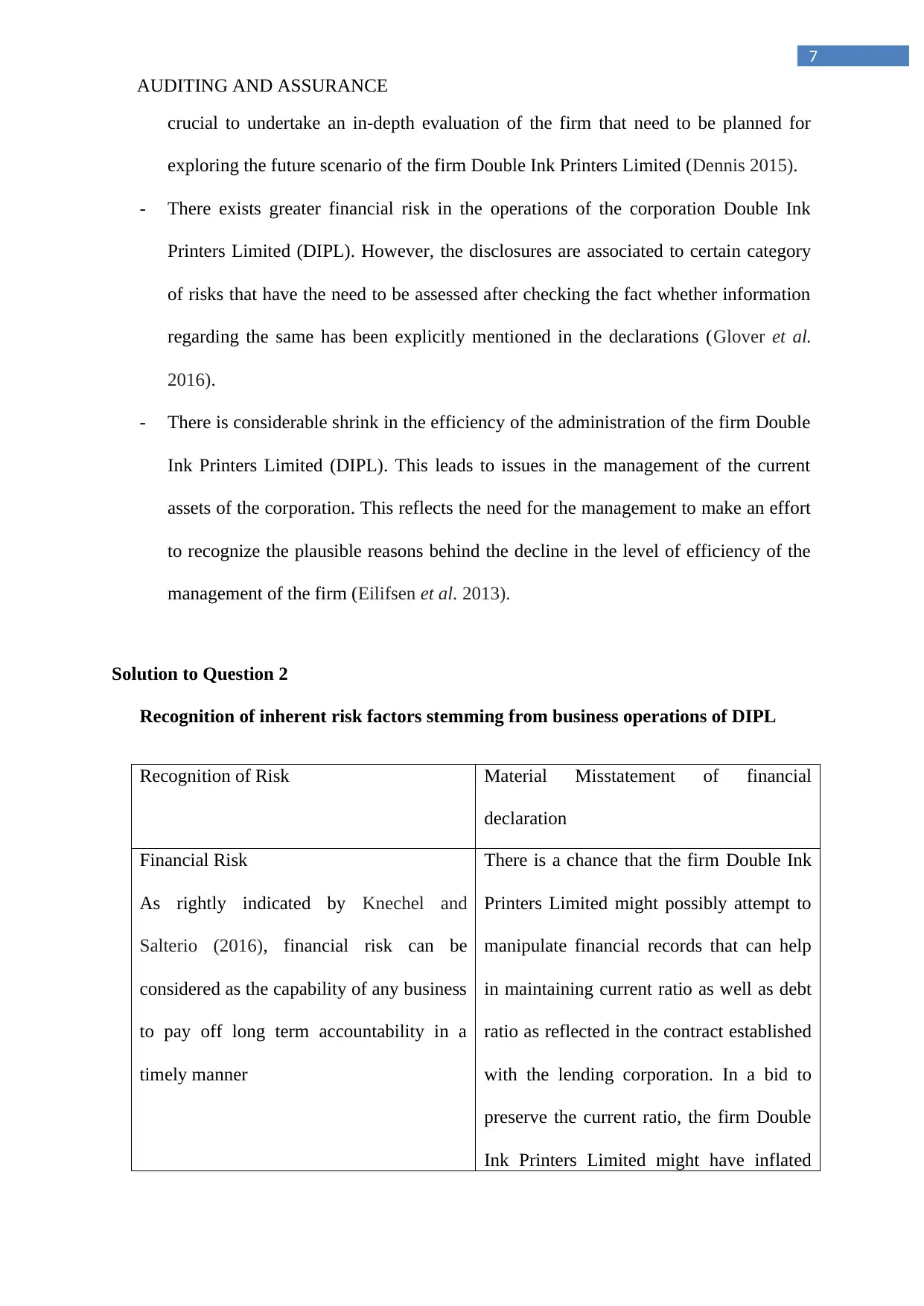
7
AUDITING AND ASSURANCE
crucial to undertake an in-depth evaluation of the firm that need to be planned for
exploring the future scenario of the firm Double Ink Printers Limited (Dennis 2015).
- There exists greater financial risk in the operations of the corporation Double Ink
Printers Limited (DIPL). However, the disclosures are associated to certain category
of risks that have the need to be assessed after checking the fact whether information
regarding the same has been explicitly mentioned in the declarations (Glover et al.
2016).
- There is considerable shrink in the efficiency of the administration of the firm Double
Ink Printers Limited (DIPL). This leads to issues in the management of the current
assets of the corporation. This reflects the need for the management to make an effort
to recognize the plausible reasons behind the decline in the level of efficiency of the
management of the firm (Eilifsen et al. 2013).
Solution to Question 2
Recognition of inherent risk factors stemming from business operations of DIPL
Recognition of Risk Material Misstatement of financial
declaration
Financial Risk
As rightly indicated by Knechel and
Salterio (2016), financial risk can be
considered as the capability of any business
to pay off long term accountability in a
timely manner
There is a chance that the firm Double Ink
Printers Limited might possibly attempt to
manipulate financial records that can help
in maintaining current ratio as well as debt
ratio as reflected in the contract established
with the lending corporation. In a bid to
preserve the current ratio, the firm Double
Ink Printers Limited might have inflated
AUDITING AND ASSURANCE
crucial to undertake an in-depth evaluation of the firm that need to be planned for
exploring the future scenario of the firm Double Ink Printers Limited (Dennis 2015).
- There exists greater financial risk in the operations of the corporation Double Ink
Printers Limited (DIPL). However, the disclosures are associated to certain category
of risks that have the need to be assessed after checking the fact whether information
regarding the same has been explicitly mentioned in the declarations (Glover et al.
2016).
- There is considerable shrink in the efficiency of the administration of the firm Double
Ink Printers Limited (DIPL). This leads to issues in the management of the current
assets of the corporation. This reflects the need for the management to make an effort
to recognize the plausible reasons behind the decline in the level of efficiency of the
management of the firm (Eilifsen et al. 2013).
Solution to Question 2
Recognition of inherent risk factors stemming from business operations of DIPL
Recognition of Risk Material Misstatement of financial
declaration
Financial Risk
As rightly indicated by Knechel and
Salterio (2016), financial risk can be
considered as the capability of any business
to pay off long term accountability in a
timely manner
There is a chance that the firm Double Ink
Printers Limited might possibly attempt to
manipulate financial records that can help
in maintaining current ratio as well as debt
ratio as reflected in the contract established
with the lending corporation. In a bid to
preserve the current ratio, the firm Double
Ink Printers Limited might have inflated
Paraphrase This Document
Need a fresh take? Get an instant paraphrase of this document with our AI Paraphraser
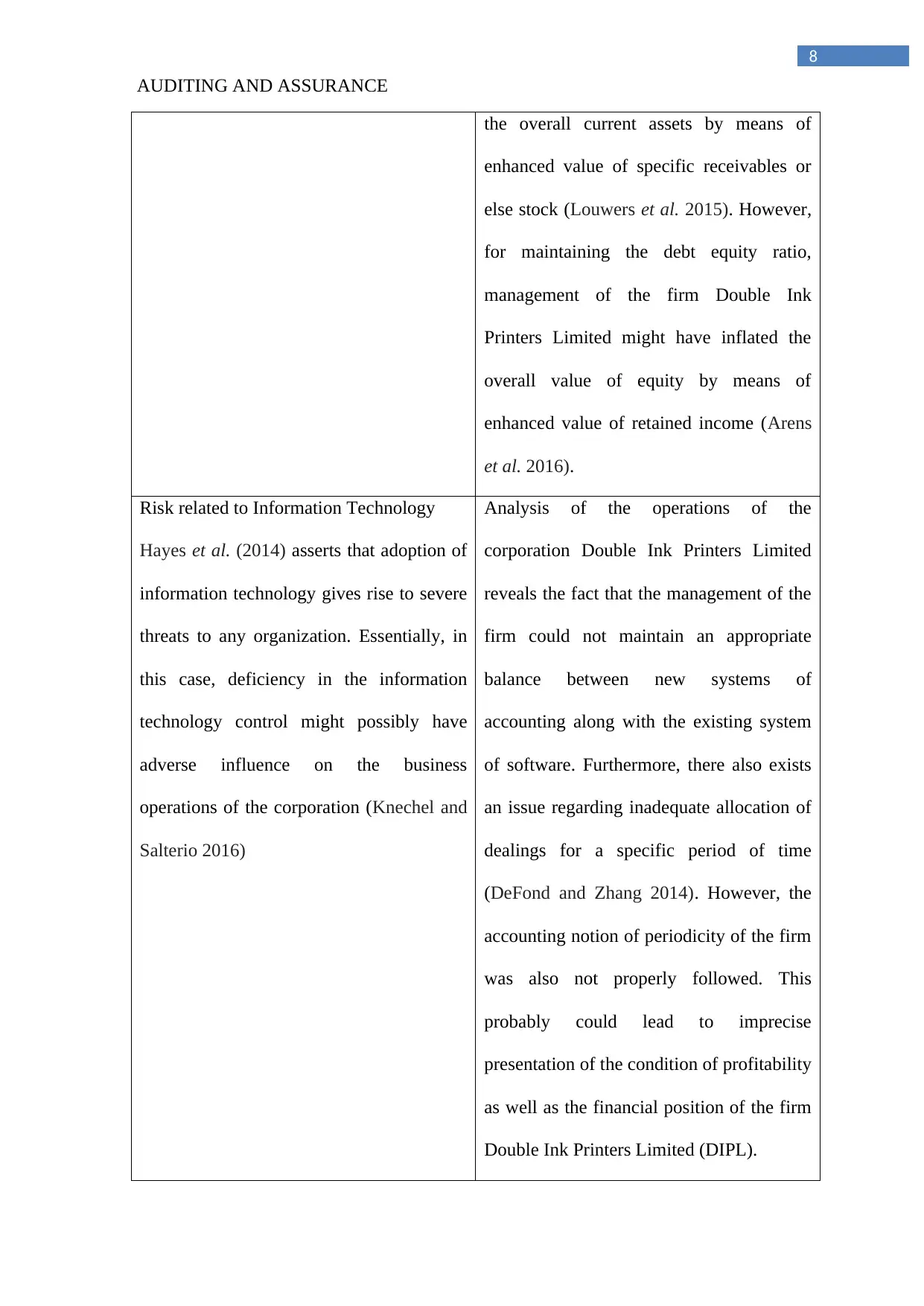
8
AUDITING AND ASSURANCE
the overall current assets by means of
enhanced value of specific receivables or
else stock (Louwers et al. 2015). However,
for maintaining the debt equity ratio,
management of the firm Double Ink
Printers Limited might have inflated the
overall value of equity by means of
enhanced value of retained income (Arens
et al. 2016).
Risk related to Information Technology
Hayes et al. (2014) asserts that adoption of
information technology gives rise to severe
threats to any organization. Essentially, in
this case, deficiency in the information
technology control might possibly have
adverse influence on the business
operations of the corporation (Knechel and
Salterio 2016)
Analysis of the operations of the
corporation Double Ink Printers Limited
reveals the fact that the management of the
firm could not maintain an appropriate
balance between new systems of
accounting along with the existing system
of software. Furthermore, there also exists
an issue regarding inadequate allocation of
dealings for a specific period of time
(DeFond and Zhang 2014). However, the
accounting notion of periodicity of the firm
was also not properly followed. This
probably could lead to imprecise
presentation of the condition of profitability
as well as the financial position of the firm
Double Ink Printers Limited (DIPL).
AUDITING AND ASSURANCE
the overall current assets by means of
enhanced value of specific receivables or
else stock (Louwers et al. 2015). However,
for maintaining the debt equity ratio,
management of the firm Double Ink
Printers Limited might have inflated the
overall value of equity by means of
enhanced value of retained income (Arens
et al. 2016).
Risk related to Information Technology
Hayes et al. (2014) asserts that adoption of
information technology gives rise to severe
threats to any organization. Essentially, in
this case, deficiency in the information
technology control might possibly have
adverse influence on the business
operations of the corporation (Knechel and
Salterio 2016)
Analysis of the operations of the
corporation Double Ink Printers Limited
reveals the fact that the management of the
firm could not maintain an appropriate
balance between new systems of
accounting along with the existing system
of software. Furthermore, there also exists
an issue regarding inadequate allocation of
dealings for a specific period of time
(DeFond and Zhang 2014). However, the
accounting notion of periodicity of the firm
was also not properly followed. This
probably could lead to imprecise
presentation of the condition of profitability
as well as the financial position of the firm
Double Ink Printers Limited (DIPL).
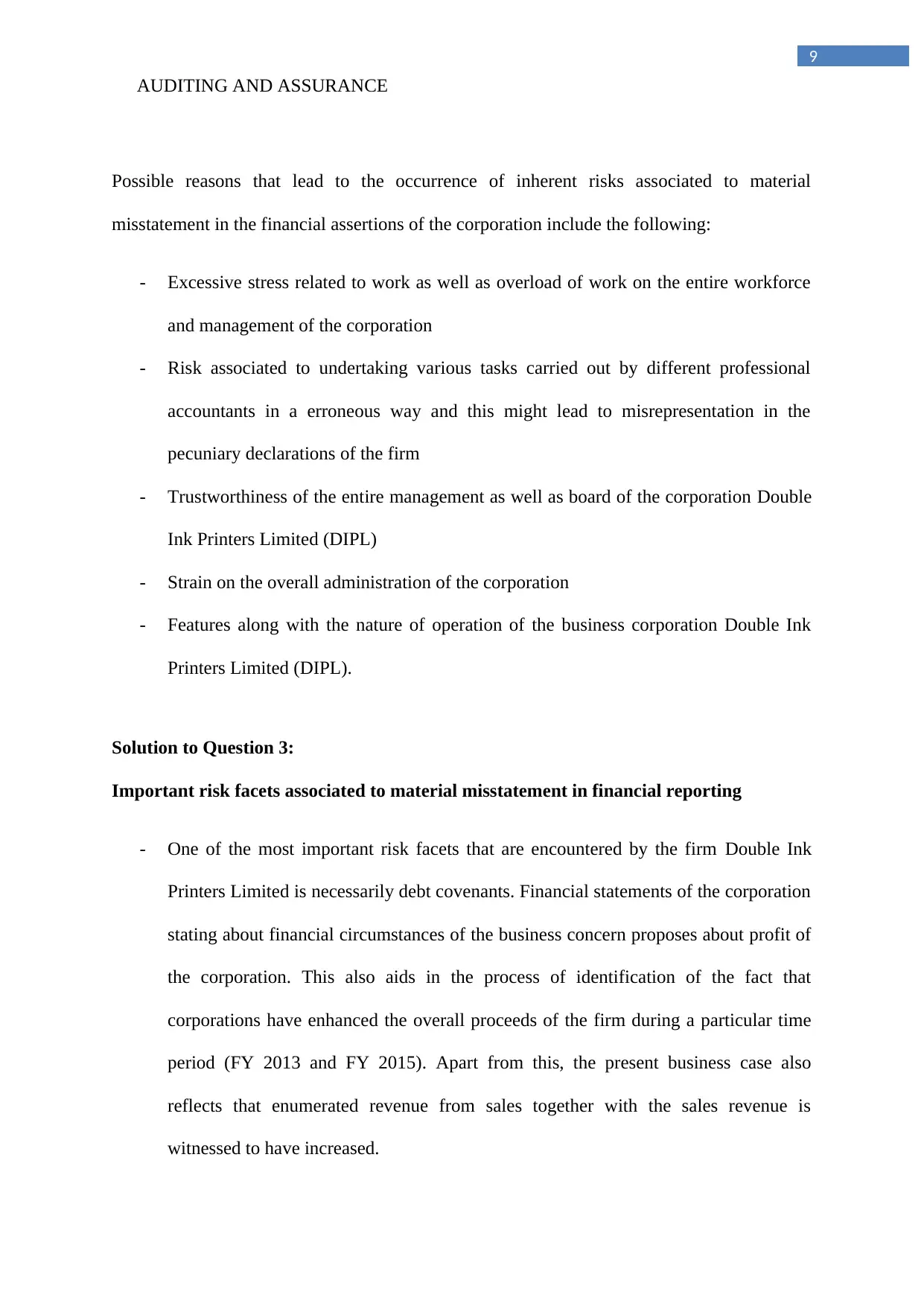
9
AUDITING AND ASSURANCE
Possible reasons that lead to the occurrence of inherent risks associated to material
misstatement in the financial assertions of the corporation include the following:
- Excessive stress related to work as well as overload of work on the entire workforce
and management of the corporation
- Risk associated to undertaking various tasks carried out by different professional
accountants in a erroneous way and this might lead to misrepresentation in the
pecuniary declarations of the firm
- Trustworthiness of the entire management as well as board of the corporation Double
Ink Printers Limited (DIPL)
- Strain on the overall administration of the corporation
- Features along with the nature of operation of the business corporation Double Ink
Printers Limited (DIPL).
Solution to Question 3:
Important risk facets associated to material misstatement in financial reporting
- One of the most important risk facets that are encountered by the firm Double Ink
Printers Limited is necessarily debt covenants. Financial statements of the corporation
stating about financial circumstances of the business concern proposes about profit of
the corporation. This also aids in the process of identification of the fact that
corporations have enhanced the overall proceeds of the firm during a particular time
period (FY 2013 and FY 2015). Apart from this, the present business case also
reflects that enumerated revenue from sales together with the sales revenue is
witnessed to have increased.
AUDITING AND ASSURANCE
Possible reasons that lead to the occurrence of inherent risks associated to material
misstatement in the financial assertions of the corporation include the following:
- Excessive stress related to work as well as overload of work on the entire workforce
and management of the corporation
- Risk associated to undertaking various tasks carried out by different professional
accountants in a erroneous way and this might lead to misrepresentation in the
pecuniary declarations of the firm
- Trustworthiness of the entire management as well as board of the corporation Double
Ink Printers Limited (DIPL)
- Strain on the overall administration of the corporation
- Features along with the nature of operation of the business corporation Double Ink
Printers Limited (DIPL).
Solution to Question 3:
Important risk facets associated to material misstatement in financial reporting
- One of the most important risk facets that are encountered by the firm Double Ink
Printers Limited is necessarily debt covenants. Financial statements of the corporation
stating about financial circumstances of the business concern proposes about profit of
the corporation. This also aids in the process of identification of the fact that
corporations have enhanced the overall proceeds of the firm during a particular time
period (FY 2013 and FY 2015). Apart from this, the present business case also
reflects that enumerated revenue from sales together with the sales revenue is
witnessed to have increased.
⊘ This is a preview!⊘
Do you want full access?
Subscribe today to unlock all pages.

Trusted by 1+ million students worldwide
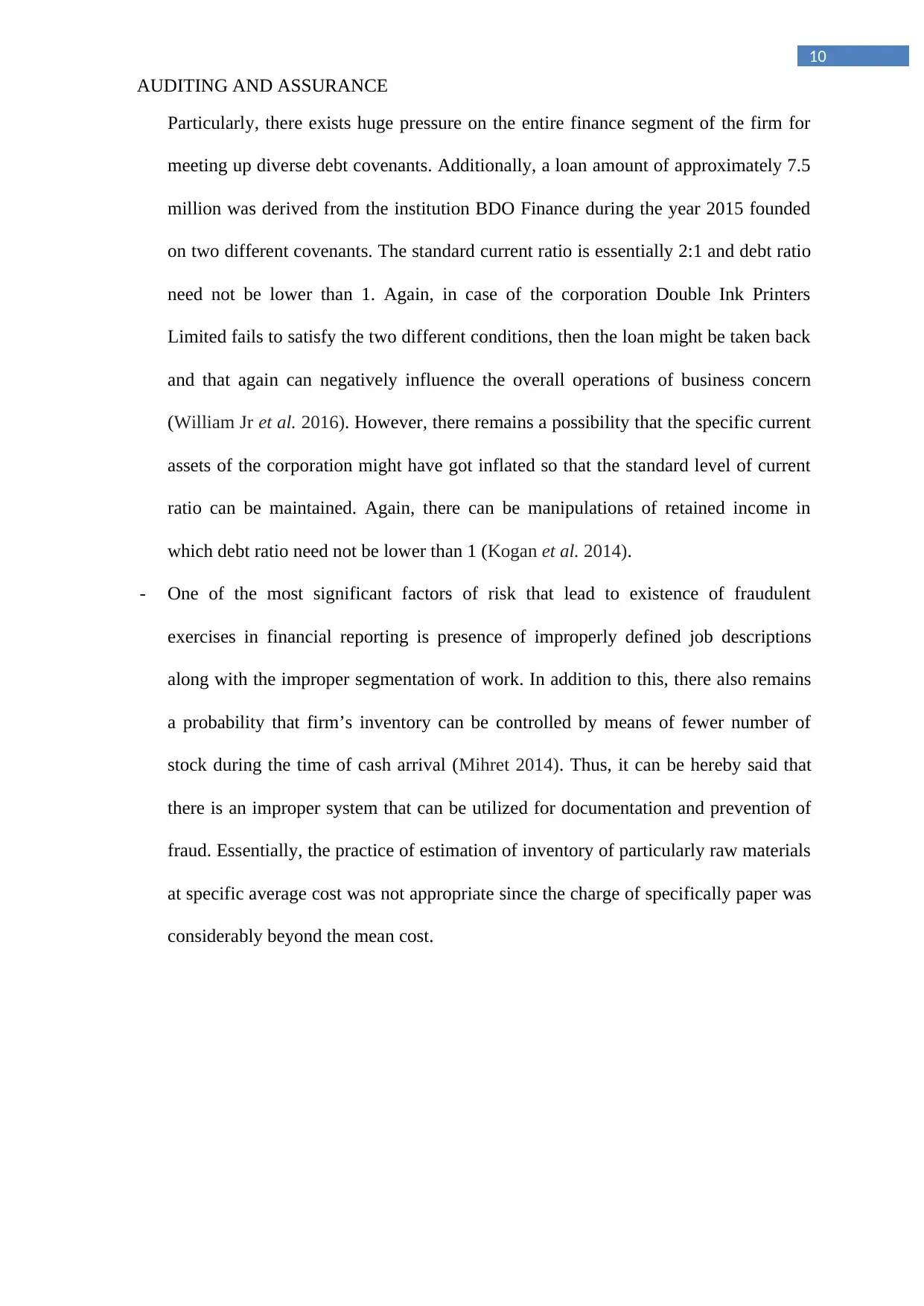
10
AUDITING AND ASSURANCE
Particularly, there exists huge pressure on the entire finance segment of the firm for
meeting up diverse debt covenants. Additionally, a loan amount of approximately 7.5
million was derived from the institution BDO Finance during the year 2015 founded
on two different covenants. The standard current ratio is essentially 2:1 and debt ratio
need not be lower than 1. Again, in case of the corporation Double Ink Printers
Limited fails to satisfy the two different conditions, then the loan might be taken back
and that again can negatively influence the overall operations of business concern
(William Jr et al. 2016). However, there remains a possibility that the specific current
assets of the corporation might have got inflated so that the standard level of current
ratio can be maintained. Again, there can be manipulations of retained income in
which debt ratio need not be lower than 1 (Kogan et al. 2014).
- One of the most significant factors of risk that lead to existence of fraudulent
exercises in financial reporting is presence of improperly defined job descriptions
along with the improper segmentation of work. In addition to this, there also remains
a probability that firm’s inventory can be controlled by means of fewer number of
stock during the time of cash arrival (Mihret 2014). Thus, it can be hereby said that
there is an improper system that can be utilized for documentation and prevention of
fraud. Essentially, the practice of estimation of inventory of particularly raw materials
at specific average cost was not appropriate since the charge of specifically paper was
considerably beyond the mean cost.
AUDITING AND ASSURANCE
Particularly, there exists huge pressure on the entire finance segment of the firm for
meeting up diverse debt covenants. Additionally, a loan amount of approximately 7.5
million was derived from the institution BDO Finance during the year 2015 founded
on two different covenants. The standard current ratio is essentially 2:1 and debt ratio
need not be lower than 1. Again, in case of the corporation Double Ink Printers
Limited fails to satisfy the two different conditions, then the loan might be taken back
and that again can negatively influence the overall operations of business concern
(William Jr et al. 2016). However, there remains a possibility that the specific current
assets of the corporation might have got inflated so that the standard level of current
ratio can be maintained. Again, there can be manipulations of retained income in
which debt ratio need not be lower than 1 (Kogan et al. 2014).
- One of the most significant factors of risk that lead to existence of fraudulent
exercises in financial reporting is presence of improperly defined job descriptions
along with the improper segmentation of work. In addition to this, there also remains
a probability that firm’s inventory can be controlled by means of fewer number of
stock during the time of cash arrival (Mihret 2014). Thus, it can be hereby said that
there is an improper system that can be utilized for documentation and prevention of
fraud. Essentially, the practice of estimation of inventory of particularly raw materials
at specific average cost was not appropriate since the charge of specifically paper was
considerably beyond the mean cost.
Paraphrase This Document
Need a fresh take? Get an instant paraphrase of this document with our AI Paraphraser
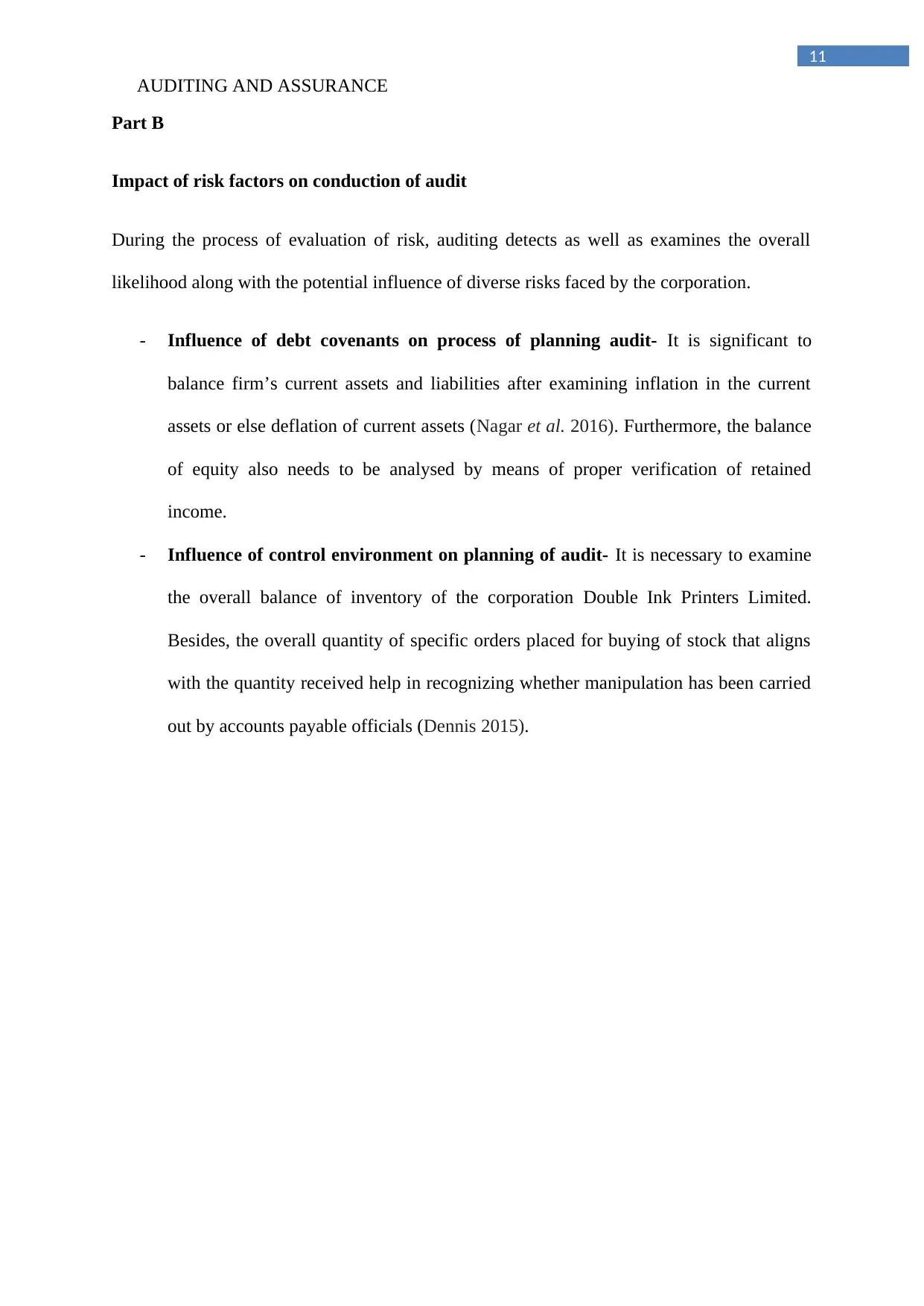
11
AUDITING AND ASSURANCE
Part B
Impact of risk factors on conduction of audit
During the process of evaluation of risk, auditing detects as well as examines the overall
likelihood along with the potential influence of diverse risks faced by the corporation.
- Influence of debt covenants on process of planning audit- It is significant to
balance firm’s current assets and liabilities after examining inflation in the current
assets or else deflation of current assets (Nagar et al. 2016). Furthermore, the balance
of equity also needs to be analysed by means of proper verification of retained
income.
- Influence of control environment on planning of audit- It is necessary to examine
the overall balance of inventory of the corporation Double Ink Printers Limited.
Besides, the overall quantity of specific orders placed for buying of stock that aligns
with the quantity received help in recognizing whether manipulation has been carried
out by accounts payable officials (Dennis 2015).
AUDITING AND ASSURANCE
Part B
Impact of risk factors on conduction of audit
During the process of evaluation of risk, auditing detects as well as examines the overall
likelihood along with the potential influence of diverse risks faced by the corporation.
- Influence of debt covenants on process of planning audit- It is significant to
balance firm’s current assets and liabilities after examining inflation in the current
assets or else deflation of current assets (Nagar et al. 2016). Furthermore, the balance
of equity also needs to be analysed by means of proper verification of retained
income.
- Influence of control environment on planning of audit- It is necessary to examine
the overall balance of inventory of the corporation Double Ink Printers Limited.
Besides, the overall quantity of specific orders placed for buying of stock that aligns
with the quantity received help in recognizing whether manipulation has been carried
out by accounts payable officials (Dennis 2015).
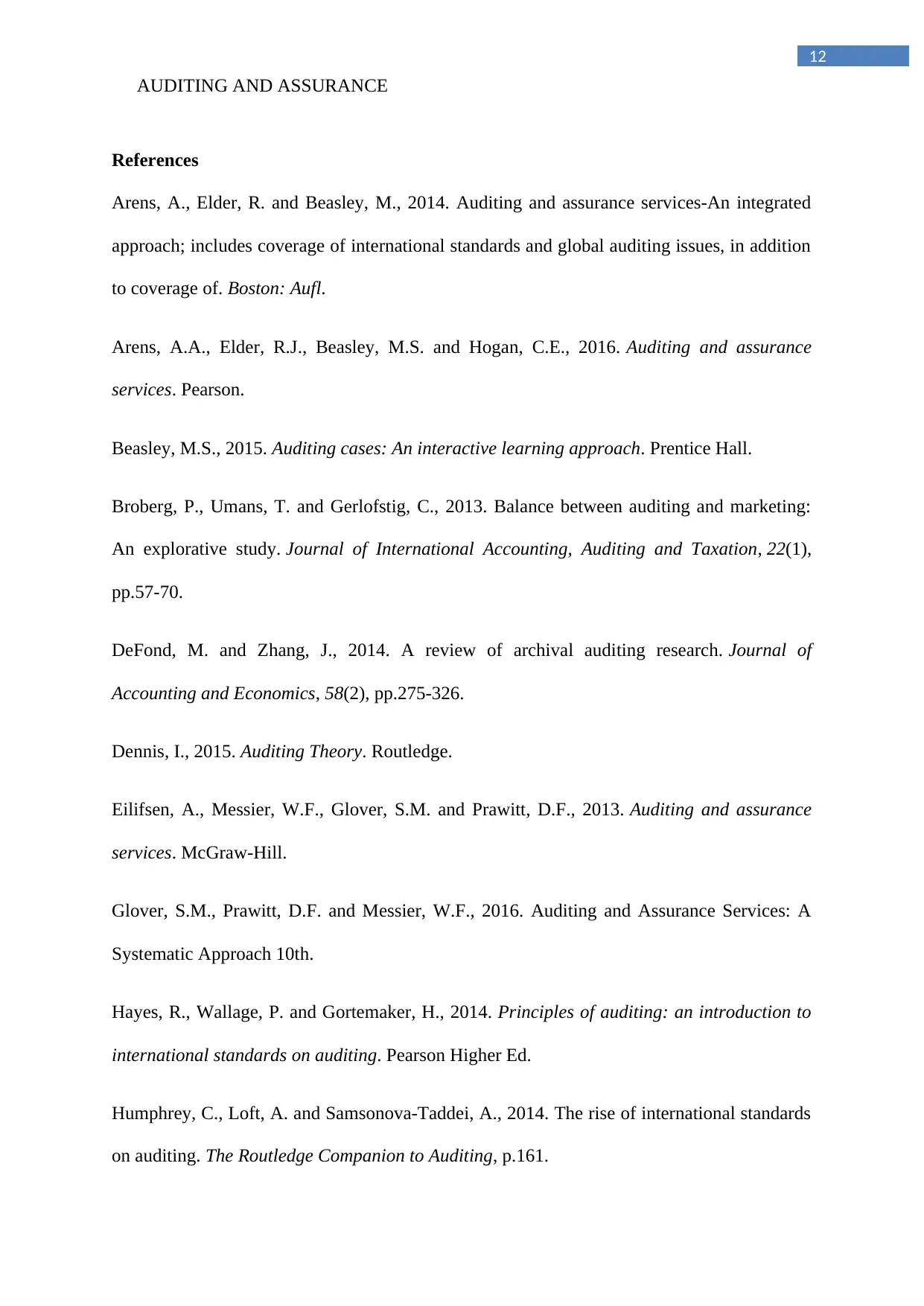
12
AUDITING AND ASSURANCE
References
Arens, A., Elder, R. and Beasley, M., 2014. Auditing and assurance services-An integrated
approach; includes coverage of international standards and global auditing issues, in addition
to coverage of. Boston: Aufl.
Arens, A.A., Elder, R.J., Beasley, M.S. and Hogan, C.E., 2016. Auditing and assurance
services. Pearson.
Beasley, M.S., 2015. Auditing cases: An interactive learning approach. Prentice Hall.
Broberg, P., Umans, T. and Gerlofstig, C., 2013. Balance between auditing and marketing:
An explorative study. Journal of International Accounting, Auditing and Taxation, 22(1),
pp.57-70.
DeFond, M. and Zhang, J., 2014. A review of archival auditing research. Journal of
Accounting and Economics, 58(2), pp.275-326.
Dennis, I., 2015. Auditing Theory. Routledge.
Eilifsen, A., Messier, W.F., Glover, S.M. and Prawitt, D.F., 2013. Auditing and assurance
services. McGraw-Hill.
Glover, S.M., Prawitt, D.F. and Messier, W.F., 2016. Auditing and Assurance Services: A
Systematic Approach 10th.
Hayes, R., Wallage, P. and Gortemaker, H., 2014. Principles of auditing: an introduction to
international standards on auditing. Pearson Higher Ed.
Humphrey, C., Loft, A. and Samsonova-Taddei, A., 2014. The rise of international standards
on auditing. The Routledge Companion to Auditing, p.161.
AUDITING AND ASSURANCE
References
Arens, A., Elder, R. and Beasley, M., 2014. Auditing and assurance services-An integrated
approach; includes coverage of international standards and global auditing issues, in addition
to coverage of. Boston: Aufl.
Arens, A.A., Elder, R.J., Beasley, M.S. and Hogan, C.E., 2016. Auditing and assurance
services. Pearson.
Beasley, M.S., 2015. Auditing cases: An interactive learning approach. Prentice Hall.
Broberg, P., Umans, T. and Gerlofstig, C., 2013. Balance between auditing and marketing:
An explorative study. Journal of International Accounting, Auditing and Taxation, 22(1),
pp.57-70.
DeFond, M. and Zhang, J., 2014. A review of archival auditing research. Journal of
Accounting and Economics, 58(2), pp.275-326.
Dennis, I., 2015. Auditing Theory. Routledge.
Eilifsen, A., Messier, W.F., Glover, S.M. and Prawitt, D.F., 2013. Auditing and assurance
services. McGraw-Hill.
Glover, S.M., Prawitt, D.F. and Messier, W.F., 2016. Auditing and Assurance Services: A
Systematic Approach 10th.
Hayes, R., Wallage, P. and Gortemaker, H., 2014. Principles of auditing: an introduction to
international standards on auditing. Pearson Higher Ed.
Humphrey, C., Loft, A. and Samsonova-Taddei, A., 2014. The rise of international standards
on auditing. The Routledge Companion to Auditing, p.161.
⊘ This is a preview!⊘
Do you want full access?
Subscribe today to unlock all pages.

Trusted by 1+ million students worldwide
1 out of 13
Related Documents
Your All-in-One AI-Powered Toolkit for Academic Success.
+13062052269
info@desklib.com
Available 24*7 on WhatsApp / Email
![[object Object]](/_next/static/media/star-bottom.7253800d.svg)
Unlock your academic potential
Copyright © 2020–2025 A2Z Services. All Rights Reserved. Developed and managed by ZUCOL.





